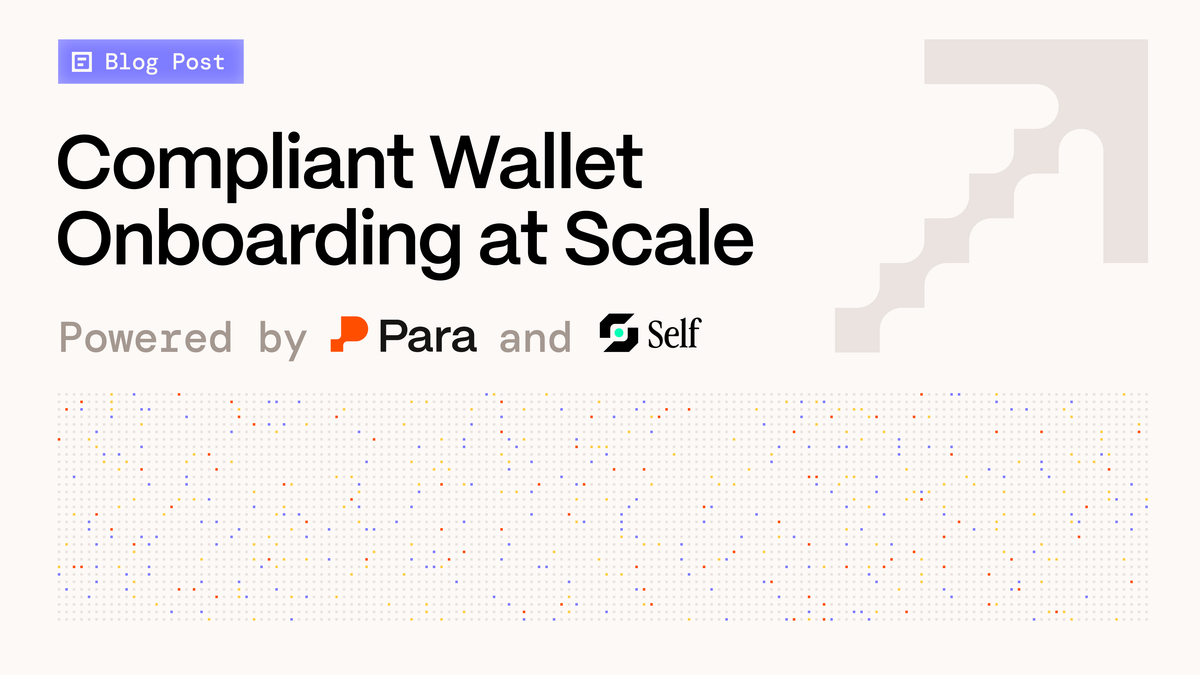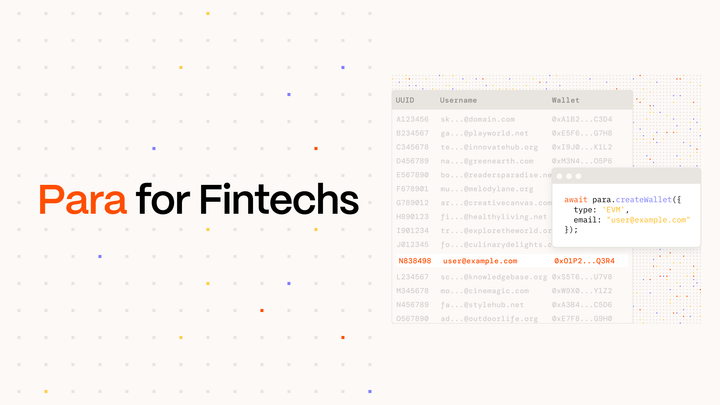Compliant Wallet Onboarding at Scale: Powered by Para and Self
Learn how Para and Self Protocol enable compliant onboarding, so fintechs and ecosystems can unlock portable identity and trust that travels across apps.

Applications that integrate crypto onboarding often face a dual challenge: providing a fast and frictionless user onboarding experience while also meeting user trust expectations and contributing to compliance requirements.
Whether you’re building a trading app or payment service, you often must prove who your users are, without compromising privacy or drowning in data liability.
Enter Self: Self is a privacy-first identity solution leveraging ZK to verify proof of humanity and key characteristics like age and country of residence (without disclosing sensitive information). Self can plug into a user's Para account, linking verified identity attributes without exposing private data.
The result? A smooth and compliant onboarding experience.
Self: Verified Credentials Without Oversharing
Self Protocol allows users with government-issued biometric passports and ID cards from 129 and 35 countries, respectively, to create their Self Pass, which leverages zero-knowledge technology to verify key characteristics about the individual (e.g. age, country of residence, humanity).
Self never sees, owns, or shares any of the users’ encrypted information—just the proof, and only with the user’s consent. Self is fully third-party audited by zksecurity and aligns with privacy-first user and compliance-aware needs for developers across apps. The protocol supports web2 and web3 use cases through onchain and offchain attestations, from providing sybil-resistant solutions to combat bot activity, to rewarding verified human users with social badges and incentives.
The Benefits of Linking Verified Credentials to Para
When developers integrate Self credentials with Para universal embedded wallets, they unlock a few key benefits:
- User-centric identity: Credentials live with the wallet; they’re not siloed in each app.
- Reduced fraud & friction without the compliance overhead: Sybil resistance and automated watchlist checks are baked into the flow. Unlock compliance-grade verification without storing any personal data.
- Portable trust: As more apps integrate Self + Para, verified users move freely across ecosystems.
Real-World Use Cases: What Para + Self Enable Together
Para and Self use cases span beyond general identity checks: they’re dynamic, app-spanning workflows.
1. Onboard Once, Access Anywhere – A user signs up for a trading app and verifies their age through Self, and that credential attaches directly to their Para wallet.
When they later try a lending app in the same ecosystem, the user's Para wallet is recognized and the existing age proof is accepted.
2. Country-Gated Access Without Data Storage – An app needs to enforce region restrictions, for example, excluding users from OFAC-listed countries. By leveraging Self’s OFAC list’s exclusion proofs, projects can verify users’ country of residence is not OFAC sanctioned, linking that verification to the user’s Para wallet.
Additional apps using Para can choose to trust Self’s verification, since it uses government-issued identification, without ever accessing sensitive country data or requiring another ID scan.
3. Sybil Resistance That Actually Works – Apps offering rewards or referrals often struggle with duplicate accounts.
Self can detect when the same ID has been used to generate multiple credentials. Para ensures that each credentialed identity is linked to a single wallet.
Get Started
- Set up wallet onboarding and authentication through Para's SDKs: Use Para’s SDK to embed wallet creation into your signup flow. Enable wallet creation with familiar login methods (email, passkey, or social login). Behind the scenes, Para provides an MPC-secured wallet and returns a unique identifier (e.g. wallet address or auth token) to your app.
- App requests a credential via Self: When needed, such as after signup or before a sensitive action, initiate a credential check. Using Self’s SDK, define the criteria (e.g. age ≥ 18), then generate a deeplink or a QR code from the SelfApp object.
const app = new SelfAppBuilder(
{
appName: "Your App Name",
endpoint: "Where you want to verify the credential, e.g. https://yourDNS.com/verify or a smart contract address. ",
userId: "supports wallet address or uuid",
disclosures:
{
minimumAge: 18,
excludedCountries: [countries.BELGIUM]
}
}).build()
const deeplink = getUniversalLink(app)Open this deep link, or generate and scan a QR code to begin verification in the Self mobile app.
- User verifies through the Self app: The user scans their NFC-enabled passport or EuID via the Self app. Self generates a zero-knowledge proof, confirming attributes like age or nationality, without revealing sensitive personal data. The proof is returned securely to your backend
- App Verifies the Proof: Leverage Self's SDK to validate the proof. The SDK will check authenticity (verifying the zero-knowledge proof) and that all criteria are met. If valid, the user is marked verified. If not, you can block access or request manual review.
- Link Credentials to Para Wallets: Once verified, attach the credential to the user’s wallet for future reference. You can choose from a couple options:
- Off-chain storage: Add a flag to your user database (e.g. age_verified = true).
- Onchain credential: Mint a Soulbound Token (SBT) or verifiable credential to the wallet address.
- Hybrid caching: Store the result and reverify only periodically, using Self’s identity commitments to prevent spoofing.
Trust That Moves With the User
Identity checks are necessary. But they don’t have to be painful for users.
By combining Self’s credentialing layer with Para universal embedded wallets and authentication, you get a model that respects user privacy and serves real compliance needs. The result is reusable trust that unlocks new experiences without adding new friction.
If your product depends on knowing your users, but not on storing their sensitive data, reach out to learn how we can help!



